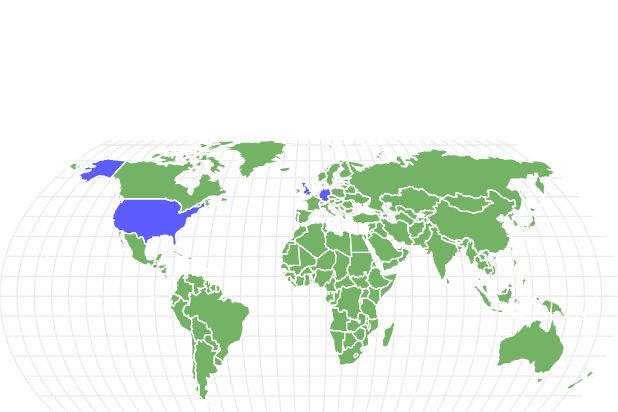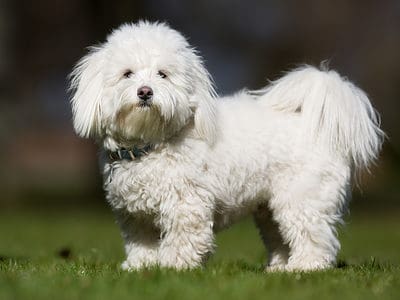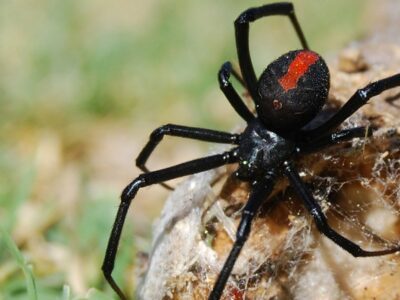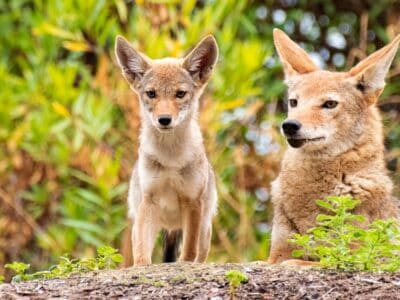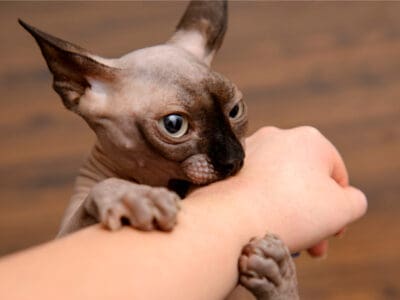Mini Lop
Oryctolagus Cuniculus
One of the cutest and most popular rabbits
Advertisement
Mini Lop Scientific Classification
- Kingdom
- Animalia
- Phylum
- Chordata
- Class
- Mammalia
- Order
- Lagomorpha
- Family
- Leporidae
- Genus
- Oryctolagus
- Scientific Name
- Oryctolagus Cuniculus
Read our Complete Guide to Classification of Animals.
Mini Lop Conservation Status
Mini Lop Facts
- Name Of Young
- Kittens
- Group Behavior
- Herd
- Fun Fact
- One of the cutest and most popular rabbits
- Biggest Threat
- diseases, some predators
- Distinctive Feature
- Powerful bodies and lop ears
- Gestation Period
- 30-31 days
- Temperament
- docile
- Litter Size
- 4-10
- Diet
- Omnivore
- Lifestyle
- Crepuscular
- Favorite Food
- Timothy Hay
- Origin
- Germany
Mini Lop Physical Characteristics
- Color
- Brown
- Grey
- Fawn
- Black
- White
- Multi-colored
- Skin Type
- Fur
- Lifespan
- 4-10 years
- Weight
- 3.5 - 6 pounds
- Age of Sexual Maturity
- 5-6 months
- Age of Weaning
- 1-2 months
- Venomous
- No
- Aggression
- Low
View all of the Mini Lop images!
Summary
The Mini Lop is one of the cutest bunnies around, and that’s saying something. Not to be confused with the UK breed of the same name, this small lop originated in Germany in the 1950s. These first mini bunnies came from the German big lop and the small Chinchilla rabbit. Upon its discovery in a German National Rabbit Show in 1972 by Bob Herschbach, where it was known as the Klein Widder, the breed then spread to the United States. Over the course of a few decades, it rose to become one of the most popular domestic rabbits in the world.
5 Mini Lop Facts
- Breeders created this small rabbit by breeding German Big Lops with small Chinchilla rabbits.
- In Germany, this little rabbit goes by the name Klein Widder, which translates to “little ram.”
- They originally came in Agouti and white but are now available in a variety of colors.
- Despite their name, they aren’t classified as dwarf rabbits due to their medium-sized, powerful bodies.
- Over the years, different breeding clubs and prominent breeders invented unique nicknames for them, including “Monarch of the Fancy,” “Lop of Excellence,” and “basketball with a head.”
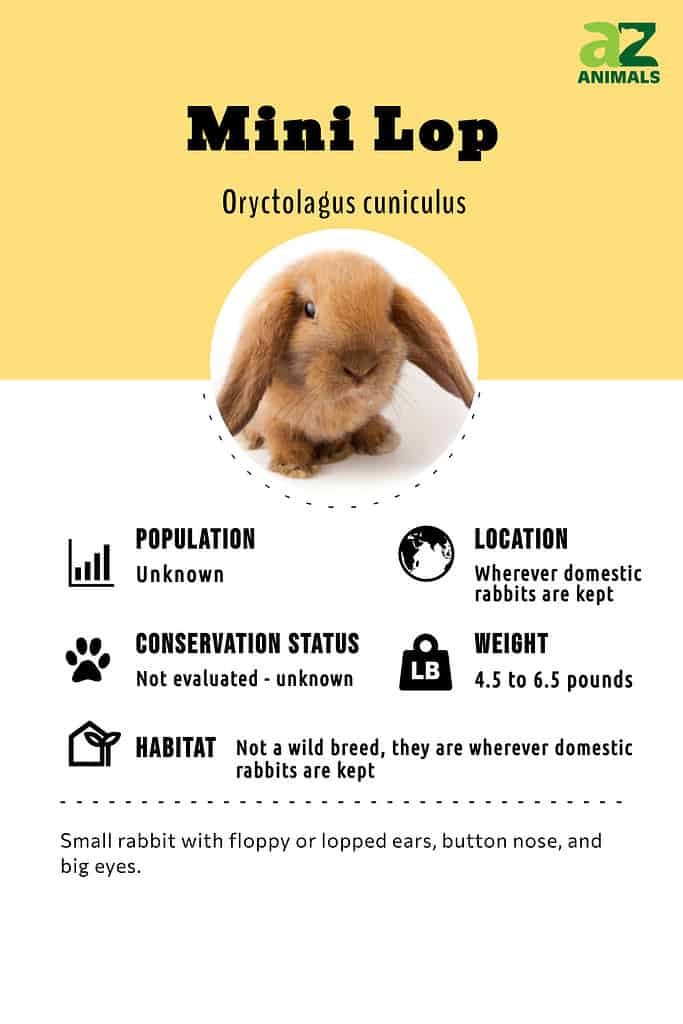
Scientific Name
The Mini Lop’s scientific name is Oryctolagus cuniculus, which it shares with all 305 known domestic rabbit breeds. In Ancient Greek, oryktos translates to “dug up,” while lagos means “hare.” As for cuniculus, the word is used interchangeably in Latin to mean both “burrow” and “rabbit.” The reason for this shared name stems from the fact that all domestic rabbits have the same wild ancestor – the European rabbit. Meanwhile, the Mini Lop’s common name stems from its lop ears and relatively small size (compared to other lop rabbits). It is not to be confused with the English breed – the Miniature Lop – which goes by the same name but grows significantly smaller.
Types Of Mini Lops
The rabbit belongs to the order Lagomorpha and the family Leporidae. There are 8 genera included in this family, but the European rabbit, from which all domestic rabbit breeds are a descendant, belongs to the Oryctolagus genus. This genus includes at least 10 types of lop rabbits. Some of these are:
- American Fuzzy Lop
- English Lop
- French Lop
- Holland Lop
- Miniature Fuzz Lop
- Dwarf Lop
- Velveteen Lop
Appearance
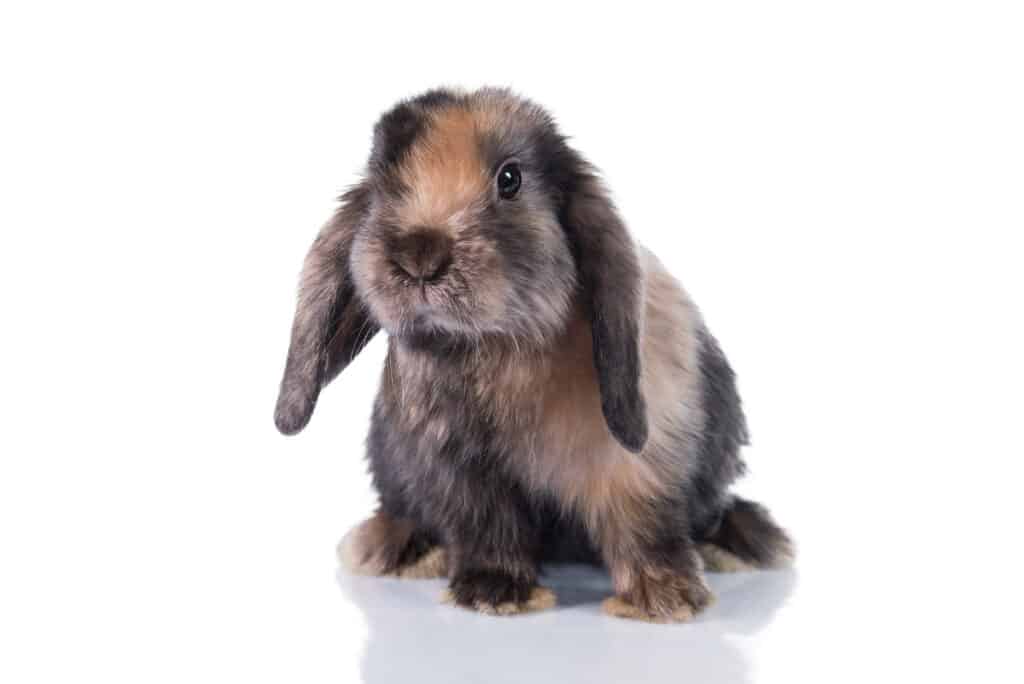
Mini Lops come in both broken, like this example, and solid color variations.
©iStock.com/Rita_Kochmarjova
Despite their name, Mini Lops aren’t that mini. On the contrary, they are classified as medium-sized rabbits and possess squat, powerful bodies. The average Mini Lop weighs between 4.5 and 6.5 pounds, with mature males typically weighing larger than females. They sport a wide head, full muzzle, and often feature a noticeably arched crown. Given their frame, It’s no wonder that the ideal Mini Lop is often described as a “basketball with a head.”
Traditionally, Mini Lops featured both Agouti (alternating bands of different colors) and white colors. However, years of breeding led to them coming in a wide range of colors, including chinchilla, chestnut Agouti, black, opal, white, chocolate, lilac, and orange. In shows, judges divide these lops into solids and brokens based on their color patterns. Their fur grows thick but not overly long and gives off a glossy, lustrous sheen.
Aside from its well-rounded frame, the Mini Lop’s other most noticeable feature is its adorable lop ears. Unlike erect ears, which stand up or to the sides of the head, lop ears hang down. In shows, an ideal Mini Lop’s ears tend to hang about 0.75 to 1 inch below the jaw.
Behavior
Like most lop-eared rabbits, Mini Lops tend to be rather laid-back and easy-going. However, they can also display skittish and nervous behaviors common in smaller breeds. The truth is that each Mini Lop has its own unique personality and set of behaviors. That said, most owners attest that Mini Lops as a whole are cheerful, playful, and chill. They are quite clever even when compared to other rabbit breeds and respond well to training. With practice, they can learn to do tricks, come when you call their name, and play certain games. Like all animals, they may bite when startled, but if handled with care and properly socialized, they are not prone to outbursts of violence.
Habitat
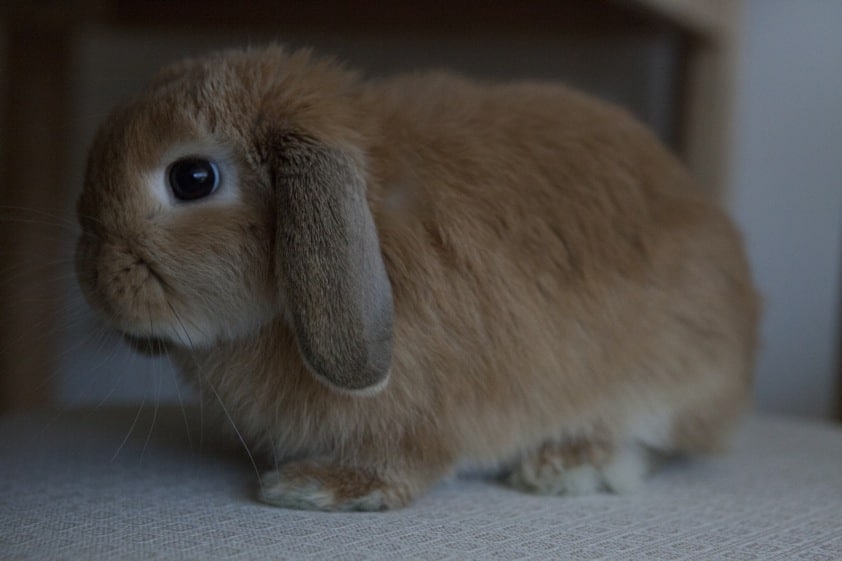
Although they aren’t the largest breed, they still require plenty of room to move around and play.
©Miniaturelop, CC BY-SA 3.0 <https://creativecommons.org/licenses/by-sa/3.0>, via Wikimedia Commons – Original / License
The first Mini Lops were bred in German sometime during the 1950s. In 1972, Rob Herschbach discovered Mini Lops at a German National Rabbit Show and shortly after introduced them to the United States. Today, you can find Mini Lops all around the world wherever domestic rabbits are kept.
As a medium-sized breed, Mini Lops fare well both indoors and outside. That said, if you decide to keep them outside, you’ll want to place their hutch in the shade out of the sun. Additionally, you may need to heat the hutch in winter, especially if you live somewhere that gets particularly cold. Although they aren’t the largest breed, they still require plenty of room to move around and play. A Mini Lop’s cage should measure at least 3 to 4 feet wide, 2 feet deep, and 3 feet high.
Diet
Like all rabbits, Mini Lops are herbivores that eat almost exclusively grasses and other vegetation. Their diet consists mostly of fresh hay grasses such as Timothy Hay which provide them with the majority of the nutrients they need. In addition to hay, Mini Lops can also eat a limited amount of fresh vegetables and fruits. Safe options include leafy greens, beans, pumpkin, broccoli, parsnips, radishes, berries, and apples. Many owners also choose to supplement their Mini Lop’s diet with a small amount of pellet food. That said, pellets shouldn’t make up more than 5% to 10% of a Mini Lop’s diet.
Predators and Threats
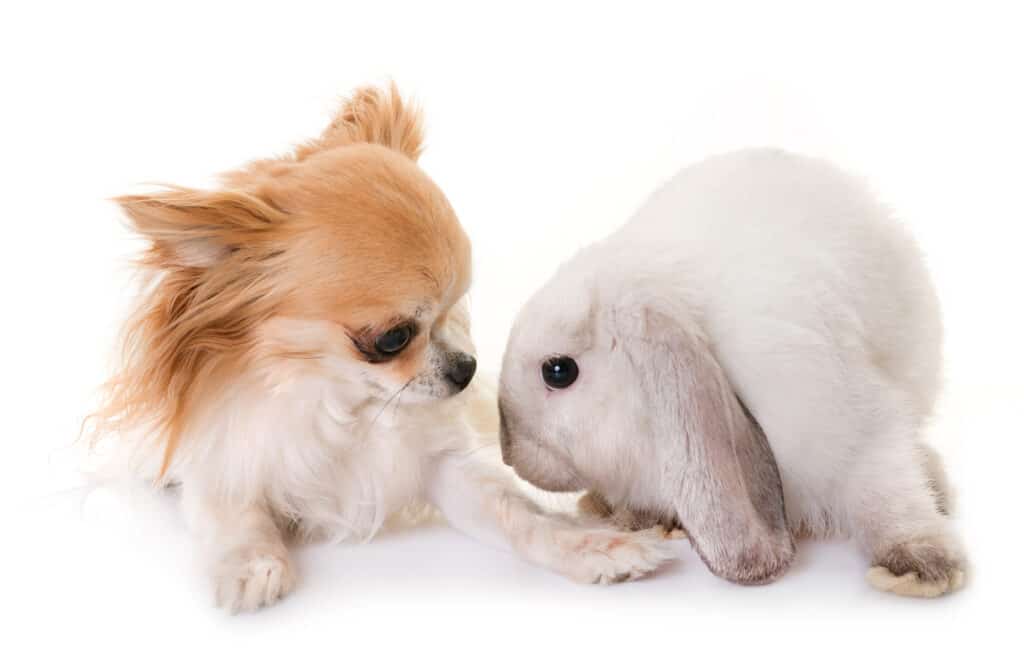
Their calm and docile nature makes Mini Lops good companions with children and other pets but larger animals can severely injure them.
©Cynoclub/Shutterstock.com
As a domestic breed, Mini Lops do not have any natural predators. However, that doesn’t mean that they face no threats. Carnivorous house pets such as cats and dogs can both severely injure a Mini Lop. Additionally, Mini Lops should be closely monitored while outside due to the threat of wild predators like birds of prey, foxes, badgers, and coyotes. Mature Mini Lops usually have nothing to fear from smaller predators such as stoats, weasels, and ferrets, but the kittens are especially vulnerable to these predators. To avoid predators, Mini Lops must rely on their keen sense of smell and hearing as well as their powerful legs to help them run away if necessary.
In addition to predators, Mini Lops are also susceptible to a host of common rabbit ailments. They commonly suffer from digestive and respiratory issues, malocclusion (misaligned teeth), head tilt, mites, and uterine cancer. It’s wise to keep a close eye on your Mini Lop to ensure they stay healthy and keep out of too much trouble.
Reproduction and Life Cycle
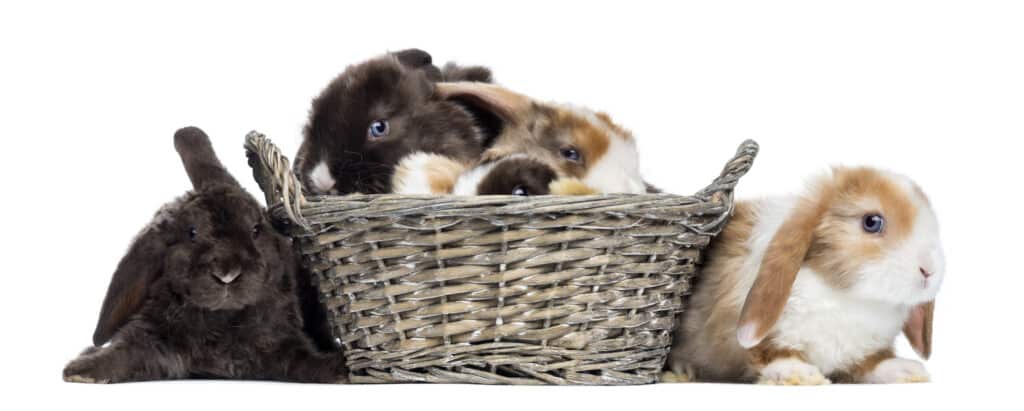
Mini Lop babies, called kittens, are typically born in litters of four to ten.
©Eric Isselee/Shutterstock.com
On average, Mini Lops sexually mature at around 5 months old. However, it’s wise to wait until does reach at least 6 months old before beginning to breed them. In the wild, rabbits are polygynous, and one male may mate with several females. The same is also true with domestic rabbits. Given their territorial nature, breeders usually take females to the males’ cages in order to avoid fights. Breeding sessions usually take place in quick succession, with short breaks in between, to increase the chance of pregnancy.
On average, females gestate their young from 30 to 31 days. Baby rabbits – also called kittens or kits – are born completely hairless and cannot even open their eyes. The average litter size is around 7 kittens but can range anywhere from 4 to 10. During the first 2 weeks of life, kittens live solely on their mother’s milk. They begin to eat some grass at around 2 weeks old and fully wean themselves at 1 or 2 months old.
Mini Lops live longer than some other domestic rabbits. Typically, Mini Lops live around 7 years but often reach between 4 and 10 years old. Depending on their health, some may live even longer, although ailments and diseases become more prevalent with age. They commonly suffer from health issues that affect other rabbits such as digestive issues, respiratory diseases, uterine cancer, balance issues, and malocclusion.
Population
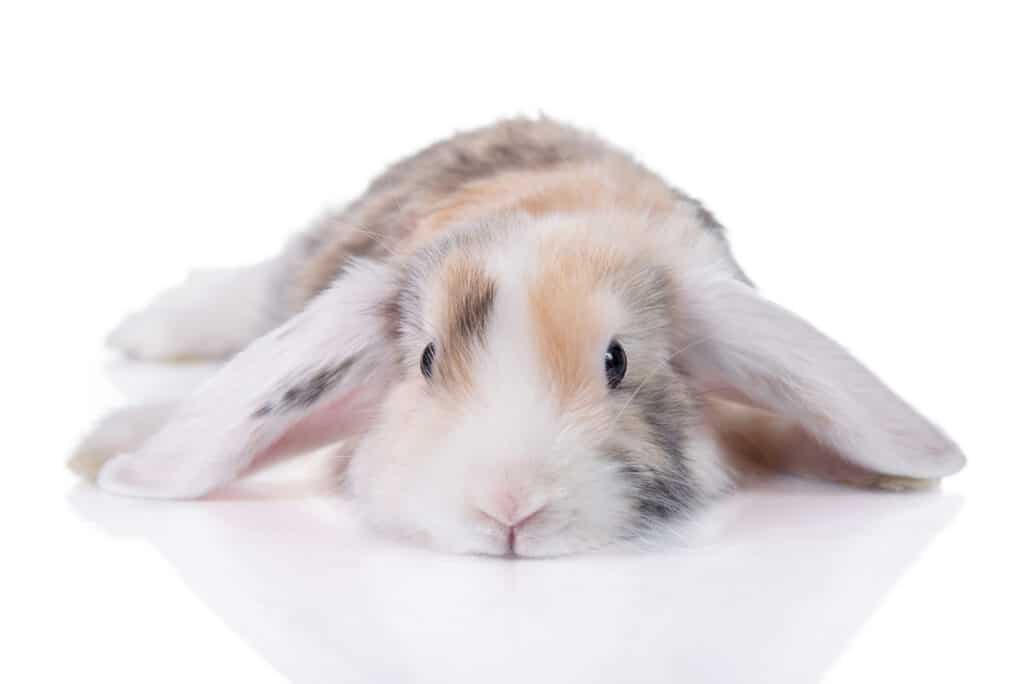
This breed ranks among the world’s most sought-after domestic rabbits.
©Rita_Kochmarjova/Shutterstock.com
The first Mini Lops were created by breeding German Big Lops with small Chinchilla rabbits. Since their discovery in Germany just 50 years ago, this breed has exploded in popularity. They quickly spread to the UK and then the US, and you can now find them throughout the world. Today, they rank among the world’s most sought-after domestic rabbit breeds. Few breeds garner as much attention as Mini Lops, and it’s easy to see why, given their cute and cuddly appearance. Although no reliable data on their numbers exist, it’s safe to say that there are likely tens of thousands of this favorite breed in the US alone.
Locations
While it originated in Germany, the Mini Lop deserves recognition as a global domestic rabbit breed. You can find this breed throughout the world, but especially in the UK and the United States. Today, groups such as the Mini Lop Club of America promote the breed and continue to further its popularity and spread. It’s hard to know for certain where exactly you can find Mini Lops, but it’s a safe bet to say that you can find them in all 50 states and throughout much of Europe.
Conservation Status
Although they are a relatively new breed, Mini Lops have quickly become extremely popular. In just a few decades, they went from complete obscurity to one of the most popular rabbits in the world. It now ranks as vastly more common and popular than its progenitors, the German Big Lop and the Chinchilla. Given its popularity and status as a domestic pet, the IUCN has Not Evaluated the Mini Lop. However, their wild ancestor – the European rabbit – is not so lucky. Due to dwindling populations in its native Iberia, the IUCN lists the European rabbit as an Endangered species.
View all 180 animals that start with MMini Lop FAQs (Frequently Asked Questions)
Are Mini Lops carnivores, herbivores, or omnivores?
Like all domestic rabbits, Mini Lops are herbivores that mostly eat grasses such as hay. In addition to hay, they can also eat a small number of fresh vegetables and fruits. Although they can eat pellet food, pellets should make up no more than 5% to 10% of their diet.
Is a Mini Lop rabbit a good pet?
Mini Lops make wonderful family pets. Not only are they cuddy and cute, but they are also quite intelligent and easy to train. They make excellent family pets and are wonderful pets for children of all ages. That said, they do require a lot of attention and can bite if not held or picked up properly.
Do Mini Lops sleep at night?
Unlike humans, Mini Lops don’t sleep at night and stay up during the day. Nor are they nocturnal, staying up all night and sleeping during the day. Instead, like all rabbits, they are crepuscular, meaning that they are most active at dusk and dawn.
How long do Mini Lops live?
Compared to some breeds, Mini Lops enjoy a relatively long lifespan. The average life expectancy of a Mini Lop varies between 7 and 12 years. Health issues and genetic conditions factor into a Mini Lop’s lifespan and can greatly affect their quality of life.
Thank you for reading! Have some feedback for us? Contact the AZ Animals editorial team.

